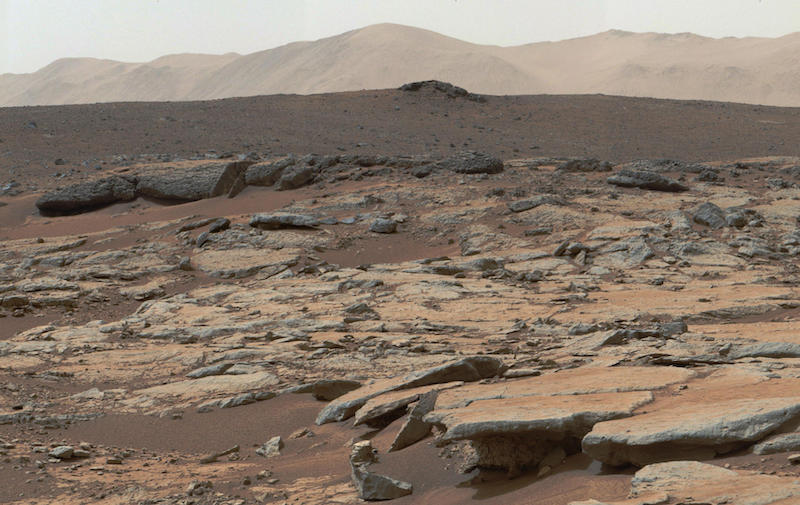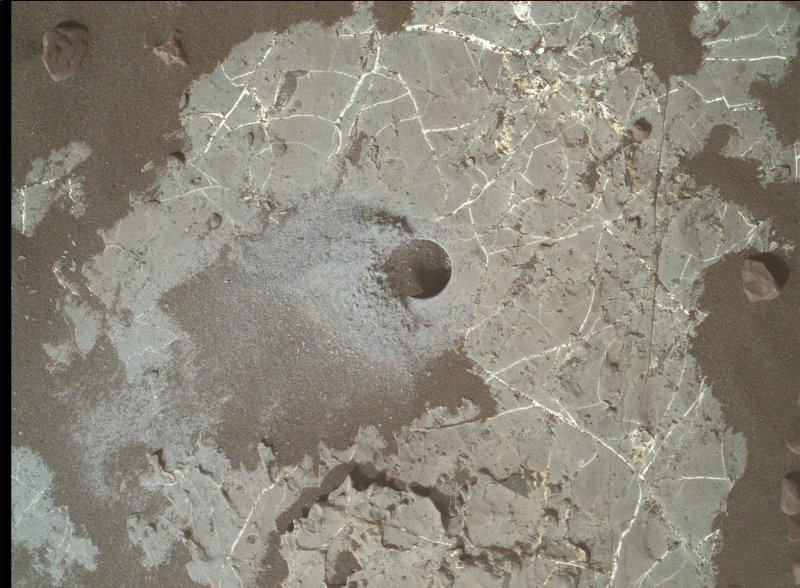
Organic carbon – key life ingredient – in Mars rocks
On June 27, 2022, NASA announced that the Mars Curiosity rover has measured the amount of organic carbon in a sample of 3.5-billion-year-old rocks drilled from the site of an ancient lake on Mars’ Gale crater. Organic carbon is carbon bound to a hydrogen atom. It’s the basis for organic molecules, and a building block of all known forms of life. NASA space scientist Jennifer Stern is lead author of paper on the findings, published in the peer-reviewed journal Proceedings of the National Academy of Sciences on June 27, 2022. She said:
Total organic carbon is one of several measurements [or indices] that help us understand how much material is available as feedstock for prebiotic chemistry and potentially biology.
We found at least 200 to 273 parts per million of organic carbon. This is comparable to, or even more than, the amount found in rocks in very low-life places on Earth, such as parts of the Atacama Desert in South America, and more than has been detected in Mars meteorites.
Rock samples from an ancient Martian lake
The rover drilled the samples of rock – called mudstone – from the site of an ancient, now-dry lake in the Yellowknife Bay formation of Mars’ Gale crater. Scientists say the mudstone formed 3.5 billion years ago, when very fine sediment – from weathering of volcanic rocks – settled to the bottom of the lake and was buried. Both active Mars rovers, Curiosity and Perseverance, have detected organic carbon molecules on Mars before, but this is the first time the amount of organic carbon has been quantified. Stern told EarthSky:
The big deal here is that we are reporting the total organic carbon in the sample … We consider this a measurement of the amount of abiotic [not derived from living organisms] organic carbon that would be available for organic chemistry. Previously detections were really crucial to telling us what kind of carbon is in Mars surface rocks, while our work presents how much carbon was there, and tries to address the question of the carbon source.
Does organic carbon mean there was life on Mars?
On Earth, organic carbon found in, say, a soil sample, indicates the presence of life. That’s because, on our planet, organic carbon is produced when plants and animals decompose. But it’s not so straightforward on Mars. There, organic carbon can also come from non-living sources, such as meteorites and volcanoes. Stern told EarthSky:
Meteorites range in organic carbon but average around 20 ppm. But there’s lots of carbon that can come in from extraterrestrial sources, so it’s likely that we are measuring those sources in addition to whatever is the Mars carbon from igneous rocks.
When doing our calculations, we made assumptions in such a way that the reported amount is the most conservative estimate, really a lower limit, so it is likely there is more organic carbon in these rocks … Even when you do that, though, the amount of carbon is still in the range of what is calculated to be contributed from the infall of extraterrestrial material on Mars. Still, the amount of carbon would have been enough to sustain very low levels of life, had it ever evolved and been present in this location on Mars.

How did Curiosity measure the organic carbon?
After Curiosity drilled samples from rocks, the rover deposited the powder into its Sample Analysis at Mars (SAM) instrument. An oven in SAM heats the samples to increasingly high temperatures. Oxygen and heat convert any organic carbon that exists to carbon dioxide (CO2). SAM then measures the amount of the gas to determine the amount of total organic carbon in the rocks.
When the samples are heated, minerals that contain carbon decompose, releasing the carbon. The oxygen and heat break apart the carbon molecules, which react with the oxygen to make carbon dioxide. This experiment cannot be conducted very often. In fact, the mission team has performed it only once so far, in 2014. It then took researchers years to analyze the resulting data.
Organic carbon isotope ratios
SAM is also capable of determining the source of the organic carbon, at least to some extent. It does this by measuring the isotopic ratios of the carbon. Isotopes are different versions of the same element. The difference is in the weight (mass) of the elements. This is due to the presence of one or more extra neutrons in the nucleus of the atoms.
Living organisms, on Earth anyway, tend to have lighter isotopes of carbon, known as carbon-12. The carbon in minerals, carbon-13, is heavier.

Biological carbon on Mars?
Could any of the organic carbon actually be biological in origin? The results are a bit inconclusive. According to Stern:
In this case, the isotopic composition can really only tell us what portion of the total carbon is organic carbon and what portion is mineral carbon. While biology cannot be completely ruled out, isotopes cannot really be used to support a biological origin for this carbon, either, because the range overlaps with igneous (volcanic) carbon and meteoritic organic material, which are most likely to be the source of this organic carbon.

Scientists first announced the discovery of enriched amounts of carbon-12 on Mars, which is crucial for life on Earth, back in January. This is carbon-12 in the same mudstone rocks in Yellowknife Bay, analyzed by Curiosity. The fact that carbon-12 exists on Mars is exciting, since on Earth, it would point to life. As this newest study shows, however, determining its origin on Mars is more difficult.
What’s next?
EarthSky asked Stern what she’d like to find out next:
I really want to know how much carbon the rocks higher up on Mount Sharp have. Our results are from the base of Gale Crater, where we believe there was an ancient lake. As we move through the layered clays and sulfates and into clays, we are looking at a very different geological, climatic, and depositional environment. Is there more carbon here, or less? By how much? It’s always so hard to extrapolate about a whole planet from one single measurement.
Getting more data on bulk organic carbon abundance could reveal how much abiotic organic chemistry was going on in the ancient atmosphere and surface, and help us understand what the baseline amount of organic carbon is, so that if we come across a sample with much more organic carbon than we expect from abiotic processes, we know that something out of the ordinary was going on, and that we should investigate further.
Bottom line: For the first time, scientists measured the amount of organic carbon – a key life ingredient – in rocks on Mars. NASA’s Curiosity rover analyzed samples taken from ancient mudstones. The results are comparable to levels of organic carbon in the Atacama Desert on Earth. The findings are inconclusive, however, as to whether any of the carbon came from ancient life.
Source: Organic carbon concentrations in 3.5-billion-year-old lacustrine mudstones of Mars











